Updated: December 2, 2025
Greece › Crete › Best Towns
By Santorini Dave • dave@santorinidave.com
Quick Tips
• Top Choice for First-Timers: Chania is the most beautiful town on the island and the best base for exploring the famous west coast beaches. Rethymno is a fantastic alternative, offering a similar Venetian charm with the added bonus of a huge sandy beach right in the city center.
• Choose Your Vibe: Go to Elounda for ultra-luxury resorts and honeymoons. Stay in Heraklio for history (Knossos) and city energy. Head to the South Coast (Loutro, Paleochora) for remote beaches, hiking, and total tranquility away from the crowds.
• Rent a Car: While the bus system along the north coast is excellent, Crete is massive. Renting a car is the only way to truly explore the mountain villages, hidden gorges, and the best uncrowded beaches on the south coast.
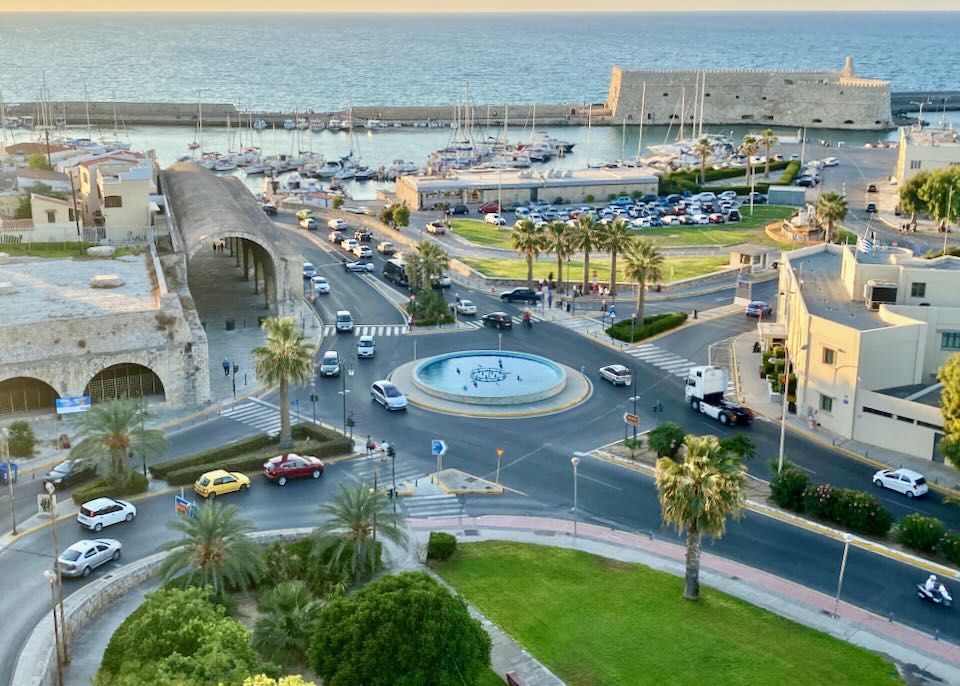
View of the port in Heraklio, Crete.
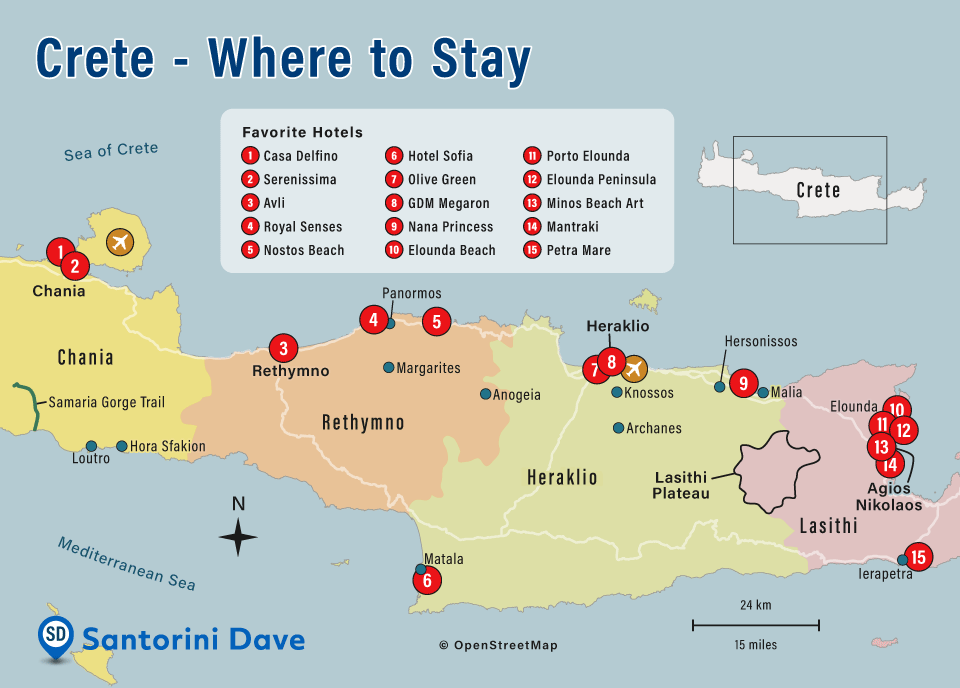
1. Casa Delfino • 2. Serenissima • 3. Avli • 4. Royal Senses • 5. Nostos Beach • 6. Hotel Sofia • 7. Olive Green • 8. GDM Megaron • 9. Nana Princess • 10. Elounda Beach • 11. Porto Elounda • 12. Elounda Peninsula • 13. Minos Beach Art • 14. Mantraki • 15. Petra Mare
The Best Areas to Stay in Crete
My Favorite Hotels in Crete
- Chania (Luxury): Casa Delfino
- Rethymno (Couples): Avli Lounge
- Heraklio: GDM Megaron
- Elounda (Beach): Elounda Beach
- Agios Nikolaos: Minos Beach Art
- For Families: Porto Elounda
- Best Pool: Elounda Peninsula
- New Hotel: JW Marriott
- Midrange: Olive Green
- Budget: Mantraki
Crete is Greece’s largest island and offers a staggering mix of wild mountains, world-class beaches, rich culinary traditions, and history dating back to the Minoans. It feels less like an island and more like a small country. With over a thousand kilometers of coastline, highlights include the pink sands of Elafonisi, the palm forest of Vai, and the lagoon of Balos. The rugged interior is home to the White Mountains and the famous Samaria Gorge. Traditional villages like Archanes and Anogeia offer a glimpse into the authentic soul of the island, while the legendary Palace of Knossos near Heraklio is the most important historical site in the Greek islands.
My two boys exploring the Chania port.
Crete is divided into four regional units. From west to east, they are: Chania, Rethymno, Heraklio, and Lasithi. For most travelers, the best places to stay are the main towns along the northern coast, which serve as perfect bases for exploration.
Chania (The Most Beautiful): Located in the west, Chania is widely considered the most beautiful town in Crete. Its romantic 14th-century Venetian Harbor and Egyptian Lighthouse are iconic. Behind the waterfront lies a stunning, car-free maze of alleyways filled with bougainvillea, boutique hotels, and incredible dining. It is the best base for visiting the famous west coast beaches like Elafonisi, Balos, and Falassarna, as well as the Samaria Gorge.
Rethymno (The All-Rounder): Located centrally between Chania and Heraklio, Rethymno offers a similar “Venetian Old Town” charm to Chania but is slightly more laid-back and less crowded. Its massive Fortezza castle dominates the skyline. Crucially, Rethymno has a long, sandy beach right in the city center, which Chania lacks. This makes it a fantastic choice for families or travelers who want history, dining, and swimming without driving.
Heraklio (History & City Life): The island’s capital is a gritty, bustling working city rather than a postcard village. However, it has incredible energy, the best food scene on the island, and is essential for history buffs. Stay here to be minutes from the Palace of Knossos and the world-class Archaeological Museum. It is also the main transit hub, home to the primary international airport and the ferry port connecting Crete to Santorini and the Cyclades.
My wife, brother, and two sons enjoying the rooftop pool at GDM Megaron with the Heraklio ferry port just visible in the background.
Elounda (Luxury Resorts): In the eastern Lasithi region, the vibe shifts completely. Elounda is the most exclusive enclave in Greece, home to VIP resorts with private peninsulas and helipads. It’s not a place for a city break; it is a place to be pampered. It is also the gateway to the historic island fortress of Spinalonga (a former leper colony made famous by Victoria Hislop’s novel The Island).
Agios Nikolaos (Chic & Scenic): Just south of Elounda, “Ag Nik” is a vibrant, picturesque town built around the “bottomless” Lake Voulismeni, which connects to the sea. It offers a sophisticated atmosphere with great cafes and shopping, serving as a livelier alternative to the isolation of Elounda. It is the perfect base for exploring the east coast beaches (like Voulisma) and the Lasithi Plateau.
Of course, there are many more outstanding places to stay in Crete, from the hippie caves of Matala in the south to the quiet fishing village of Mochlos in the east. However, for a first or second trip, these five hubs offer the best mix of infrastructure, charm, and access.
The Best Places to Stay in Crete
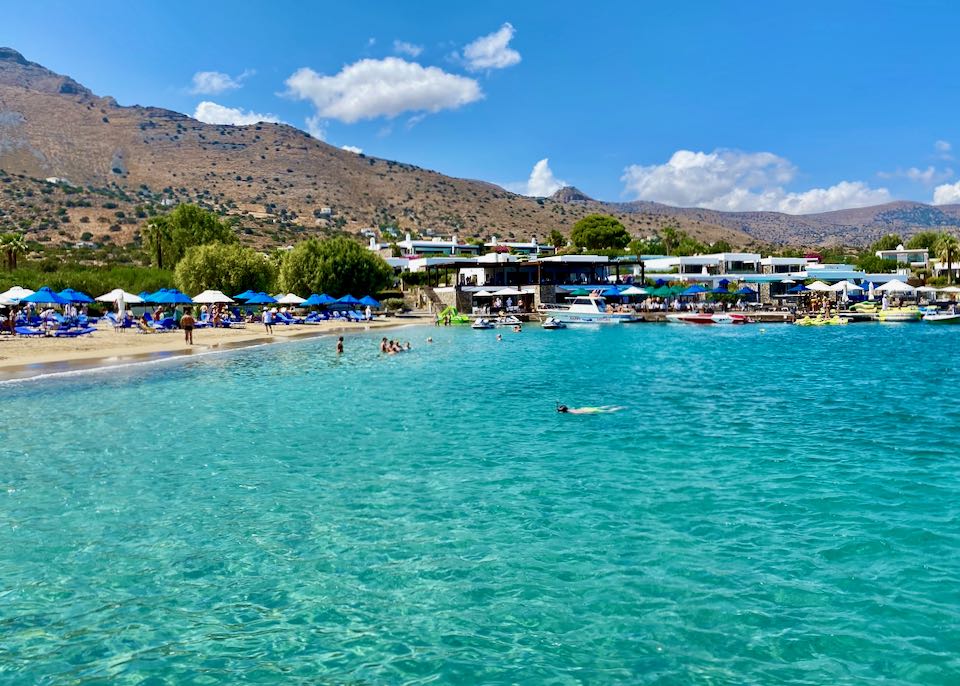
The Elounda Beach Hotel is our favorite beach resort in Crete. Fantastic!
- Best Luxury Hotels in Crete
Serenissima (Chania) • Casa Delfino (Chania) • GDM Megaron (Heraklio) • Legacy Gastro Suites (Heraklio)- Best Beach Resorts in Crete
Elounda Beach Hotel • Elounda Peninsula • Porto Elounda • Caramel Grecotel Rethymnon • Nana Princess Hersonissos- Best Honeymoon Hotels in Crete
Serenissima • Avli • Domes of Elounda • Legacy Gastro Suites • Nana Princess- Best Beach Hotels in Crete
Elounda Beach Hotel • Minos Beach Art • Domes of Elounda • St. Nicolas Bay Resort • Porto Elounda- Best Boutique Hotels in Crete
Avli • Domus Renier • Rimondi • Veneto • Palazzo Duca- Best Family Hotels in Crete
Porto Elounda • Domes Zeen • Amirandes Grecotel • Boutique Hotel del Doge • Royal Blue- Best Midrange/Cheap Hotels in Crete
Olive Green • Mantraki • Mrs. Chryssana Beach Hotel • Pavo Art Hotel • Lato Boutique Hotel • Sea & City ApartmentsBest Areas in Crete for…
- Best Place in Crete to Stay for First-Timers: Chania
Attractive Chania on the northwest coast is the best option for first-time visitors to the Crete. Easily the prettiest city on the island, Chania features a gorgeous harbor strung with sea-facing tavernas with a warren of pedestrian-only backstreets paved with pretty sandstone setts in the Old Town. Popular attractions include the Archaeology, Maritime, Byzantine, and Folk Art Museums, though much of town’s vibrant history is on open display. Chania’s storied history spans several empires, each leaving some monumental reminder: 6th-century Byzantine walls mark the borders of the Old Town, while a 16th-century Venetian fortress guards the harbor, a Venetian-Ottoman-Egyptian lighthouse guides the way. The Ottoman-era Kiutsuk Hasan Mosque (now an art gallery) sits on the harbor, while the 15th-century Etz Hayyim Synagogue (the only synagogue in Crete) rests in the heart of the Old Town. Crete in general is renowned among Greeks as the country’s culinary apex, and Chania has many of the island’s best restaurants with farm-fresh produce, aromatic herbs, and Cretan wine. Good beaches are within a short walk of town, and excellent beaches are a quick bus ride away. Other highlights of the region easy to access from Chania include the Samaria Gorge in the White Mountains and Elafonisi, the pink sand beach (you’ll need to rent a car or join a tour to visit these spots).
- Best Places in Crete to Stay for Sightseeing: Chania, Rethymno, Heraklio, Elounda, and Agios Nikolaos
For initial visits to Crete, especially if you have limited time to travel, plan on staying in one of the 5 main settlements. The five main settlements offers exceptional hotels, fantastic dining, and a wide range of nearby attractions, sights, and shops. They’re also the best places to stay in Crete if visiting without a car. Chania is considered by many visitors to be the most beautiful city on the island, and staying here puts you fairly close to the Samaria Gorge and the pink sand of Elafonisi Beach. Though it can’t compete with Chania’s beauty, Heraklio offers the most to do for those who want a jam-packed vacation, with its Archaeological Museum, Koules Fortress on the sea, hot culinary and nightlife scenes, and proximity to Knossos Palace, the island’s wine regions, and the Palace of Phaistos. Rethymno sits equidistant from Chania and Heraklio, offering a low-key version of Chania’s charm plus easy access to a swathe of beaches. To the east, Elounda and Agios Nikolaos lie side by side, both with gorgeous beaches nearby (though many in Elounda are private) and close to Spinalonga island, Psychro Cave, and the Lasithi Plateau.My two sons having lunch in Chania.
- Best Places in Crete for Families: Chania, Heraklio, and Hersonissos
Chania is a gorgeous, walkable town with plenty going on to keep kids entertained: the old harbor and lighthouse, an archaeological museum, the interactive Minoan’s World 3D Museum & 9D Cinema, the Greek National Football Museum, and Limnoupolis Water Park. Plus, this is the closest of the main cities to fascinating Elafonisi Beach. Heraklio is the largest city in Crete and filled with attractions, including the island’s largest Archaeological Museum, Watercity Waterpark, the Natural History Museum, the Historical Museum, Koules Fortress, plus a string of beaches to the west (Ammoudara is the closest great beach). Nearby is Knossos Palace, among the most important ancient sites in Greece. For pure fun and games, Hersonissos offers families a carefree vacation with a slew of all-inclusive resorts, two water parks (Star Beach and Acqua Plus), and plenty of kid-centric attractions like the Aquaworld Aquarium, Mermaid Dreams (mermaid school), the Pirates of Crete, Go Xplore quad tours, and more.- Most Romantic Places in Crete: Chania, Rethymno, Elounda, Archanes
Crete brims with romantic, seaside towns and quaint villages, but there are a few standouts. Chania is made of a pretty tangle of narrow lanes, a crescent-shaped Venetian harbor with its landmark lighthouse, and waterfront restaurants that are ideal for honeymoon or anniversary dinners. Rethymno blends Cretan, Venetian, and Ottoman elements in a more compact, less-touristy style, also with a dazzling Venetian harbor, Egyptian lighthouse, plus a 16th-century fortress. Accommodation in both towns are primarily high-end yet cozy boutique hotels (Avli Lounge Apartments and Rimondi are among the very best), and both towns boast easy access to pristine beaches. Elounda has long been favored by couples looking for a pampered getaway. Known for its luxury beachfront resorts (many all-inclusive; most with well-manicured, private beaches), Elounda also boasts a charming village center perfect for seaside strolls filled with small shops and casual yet top-notch tavernas. A short drive south of Heraklio leads to Archanes, a historic village set in the heart of the Cretan wine country, known for the dry red varieties Kotsifali and Mandilaria. The village itself is comprised of faithfully restored traditional homes, neoclassical buildings, and old Orthodox churches with cafes and tavernas spilling out onto the tree-lined sidewalks and squares.
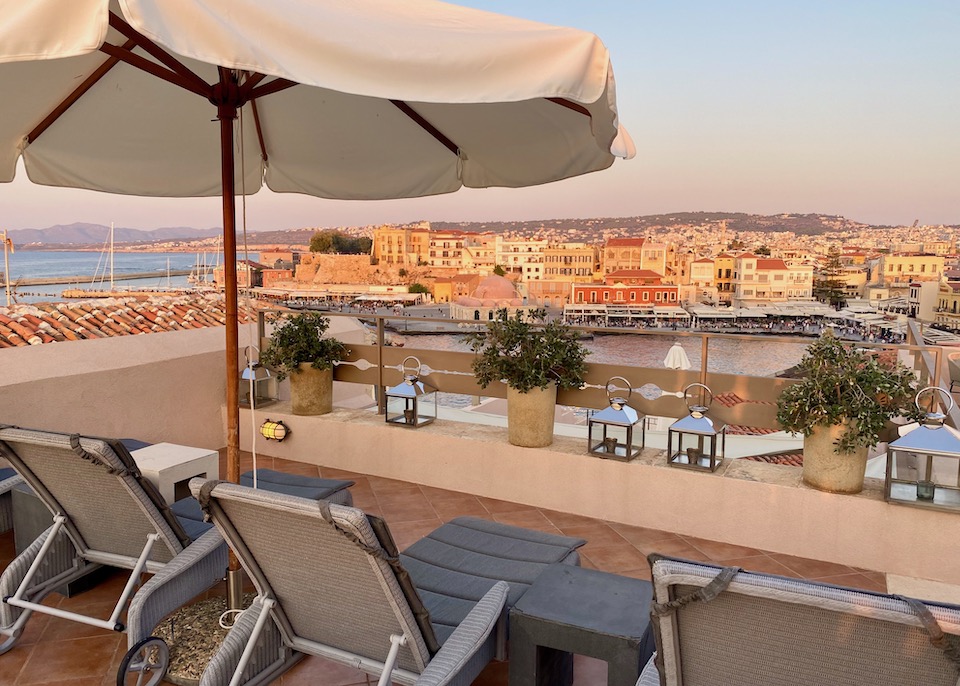
View of Chania’s harbor and Old Town as seen from Casa Delfino, the best hotel in romantic Chania.
- Best Places in Crete for the Beach: Elafonisi, Hersonissos, Bali, Matala, Elounda, and Kolymvari.
Elafonisi Beach is considered the best beach in Crete, renowned for its rosy pink sand, sparkling blue water, and nearly waveless sea. The beach itself spreads from the mainland across a causeway to Elafonisi Island. Though the mainland beach is packed and sunbeds fill up fast even in the low season (arrive by 9:00 a.m. to claim yours), walking across to the island side of the beach offers plenty of sandy space to call your own. The nearest major town to Elafanisi is Chania (about a 90-minute drive away), but if the beach is your primary goal and you don’t require outside entertainment, opt for a stay at Elafonisi Resort, the closest hotel to the beach, about a 10-minute walk. Hersonissos is the most popular beach resort in Crete. Though the beach here is narrow, it is filled with sunbeds, beach clubs, restaurants, nightlife, and water sports for an action-packed vacation. Bali is about as relaxed a vacation spot as you’ll find in Crete, a string of bays and sandy beaches along the island’s north coast, threaded with tavernas, bars, cafes, and mostly moderately-priced hotels and resorts. On the south coast, Matala sits in a sheltered cove with natural caves set in the cliffs above, fun for exploring and popular for day trips. There are plenty of delicious restaurants, beach clubs, and little shops to wander in here, plus a short hike to the less crowded Red Beach just south. Elounda is the best pick for an ultra-luxe beach stay, with swanky all-inclusive resorts offering private beaches with food and drink service – you will need to be a resort guest to use most beaches in Elounda or else make your way north to the public, pebbly Plaka Beach. Finally, Kolymvari is a sweet little strip of beach stretching east from a small port with a range of luxury and moderately-priced hotels, authentic tavernas, laid-back beach clubs, and even a small water park inside Selini Suites (day pass is €20/adult and €15/children and includes food and drinks). Kolymvari is wonderfully located just a 20-minute drive to Chania, perfect for enjoying the beach by day then heading into town for dinner or sightseeing.- Best Places in Crete for Nightlife: Heraklio, Malia, Hersonissos
Heraklio is the largest city in Crete and where you’ll find the highest concentration of cocktail bars, dive bars, and nightclubs, most open until 4:00 a.m. and some open until after sunup. Bars and clubs in Heraklio are mostly located in the heart of the Old Town within easy walking distance from each other. Bars are scattered throughout the downtown area, while most nightclubs are concentrated a few blocks due south of the old harbor between Epimenidou and Dedalou Streets. Outside of the capital, Malia is the biggest party spot. The vast majority of bars, clubs, and restaurants here sit on Dimokratias Street between Grammatikaki and the fork in the road at Mattheou Zachariadi, all within about a 5-minute walk. And whether you’re staying on the beach or in Malia’s Old Town, most hotels are only a 10 to 15-minute walk from the bar strip. Unlike Heraklio and Malia, Hersonissos’ nightlife mostly takes place along the beachfront. Bars and nightclubs run from the harbor at the north end down south for about 800 meters. Bars bookend the strip with nightclubs in the center; restaurants are scattered for the full length.The 5-star GDM Megaron sits near the harbor and Koules Fortress. This is the best luxury hotel in Heraklio.
- Best Places in Crete for Food and Restaurants: Everywhere
When it comes to gastronomy, Crete is the pride of Greece. Almost everything you will eat in Crete is farmed, foraged, raised, or fished on the island (or just off the coast). Farm-to-table dining is king, and everything plated is fresh and seasonal. The island is also one of the largest and oldest wine-producing regions in Greece, with 11 indigenous grapes grown over 4 major regions (3 directly south of Heraklio and 1 in Sitia) producing 7 white and 4 red varieties – along with other Greek and Mediterranean strains which also grow well here. Exceptional food and drink is the norm here; you’ll be hard-pressed to find a bad meal anywhere, whether seeking out rustic cuisine, traditional comfort food, or creative contemporary fare. The best restaurants in the larger towns include Chrisostomos (Chania), Tamam (Chania), Avli (Rethymno), Achinos (Rethymno), Peskesi (Heraklio), Kastella (Heraklio), and To Karnagio (Agios Nikolaos). However, some of the best dining experiences are found in the rural villages; more than worth the drive are Gianni’s Taverna (AKA The Tavern of John in Kiparissos, about 25 km south of Heraklio) and Ntounias (Drakona, about 22 km south of Chania).- Best Places in Crete for a Local Vibe: Heraklio, Anogeia, Archanes, and Hora Sfakion
Heraklio is the least touristy of the island’s main towns, despite its wealth of archaeological sites, museums, busy ferry port, and international airport. A bit gritty on the surface, Crete’s capital is a vibrant city brimming with restaurants, bars, and clubs where local Cretans are happy to mingle with travelers as much as each other. But it is overall a modern, working-class town. For a taste of the more traditional local life, you’ll want to venture farther from the north coast. Anogeia is a mountain village about 40 km from Heraklio. Residents here tend to occupy themselves as farmers, shepherds, and weavers and are known for their hospitality and penchant for wearing traditional clothing. Archanes, only 15 km from Heraklio, is a lovingly restored farming village in the island’s wine country, popular with local Cretans for their outstanding restaurants, artisanal shops, and pleasant cobblestone streets. On the south side of the island on the far side of the wildest, most rugged mountains of Crete, Hora Sfakion is a small village that has historically been the center of Crete’s resistance movements against the Venetians and later Ottomans. Villagers here are mostly fishers, olive farmers, shepherds, and goatherds (aside from the summer months, when the ferries and taverns serve hikers leaving the Samaria Gorge). Staying here is all about engaging with the locals at the small taverns circling the harbor. You’ll also find small, pebbly Vrisi Beach to the west of town.The 20 Best Places in Crete for Tourists
Chania
Chania is the best spot on the island for fantastic photos and high-end Cretan dining. The Old Town is a walled 14th Century Venetian settlement renowned today for its pretty harbor, narrow streets, and abundant waterfront and backstreet restaurants – some of which operate in summer without roofs. A striking 16th-century lighthouse guards the harbor’s entrance, a Venetian, Egyptian and Ottoman construction. Chania boasts a Nautical and an Archaeological Museum the latter housed in a former monastery. Chania’s draw is its sheer spirit of place from its busy, unavoidably likable atmosphere, walkability, and buzzing social ambiance. You are more likely to meet a long-lost friend here than anywhere else in Crete. While not a beach destination per se, you can easily walk to a couple of local beaches for a dip or take a bus or cab (5km) to Chrysi Akti. Alternatively, you can pick a place to stay on the beach annex of Platanias/Agia Marina 14 km to the East and come to Chania when the mood dictates.
- Best Hotels: Casa Delfino • Serenissima • Domus Renier • Palazzo Duca • Domes Zeen • Domes Noruz • Boutique Hotel del Doge
Rethymno
Rethymno used to be the rather looked-down-upon town of the north coast. Neglected over the years it was usually passed over by travelers heading to Chania further west. Today, it is a bustling, pretty town every bit as good as Chania and anywhere else in Crete. It occupies the middle ground in tourism and traveler stakes and is more personable, compact, and even friendlier than its larger siblings. Its real charm lies in its almost completely pedestrianized Old Town with tree-shaded or street-seated tavernas of high quality. A pretty old port (smaller though similar to Chania’s) is the focal point. From here the byzantine, narrow streets of the old quarter radiate out like a spider’s web. Visitors are encouraged to stay in the Old Town, though you can opt for the beach annex running eastwards where you can find some excellent quality hotel resorts. Access to Rethymno is easy and although the passenger ferries no longer run, the town is the central hub of the Heraklio-Chania route and equidistant from either airport. In short, a good choice for an organized package holiday or for a 2-3 day stay for island tourers with a car.
- Best Hotels: Avli Lounge Apartments • Rimondi Boutique Hotel • Veneto Hotel • Casa Vitae • Grecotel Creta Palace • Neratze Hammam Suites
Heraklio
Heraklio has undergone significant urban gentrification and is now a destination in its own right. It has a lot going for it. It’s the main port back to the mainland and the only exit point for the popular Crete-Santorini-Mykonos axis. Crete’s primary international airport lies conveniently just 3 km from the town center and the island’s primary archaeological gems – the Koules Fortress, the Archaeological Museum, Knossos Palace, and the Palace of Phaistos – are located here or nearby. Heraklio is above all the capital of Crete. Here Cretans, Greeks, and foreigners mingle to live, work, and have fun. Accommodation is of the upper market business hotel type, but with at least one new ‘green boutique’ hotel pitched at travelers, plus a variety of middle-market, more aging establishments. The streets have been re-paved, pedestrianized, and re-humanized, and each night sees a tide of people eating, drinking, walking and socializing. Heraklio is not a beach city, and even those within easy reach are not rich pickings. Heraklio will suit urbanites, nightlifers, archaeology buffs, and people looking for easy transit to and from Crete.
- Best Hotels: GDM Megaron • Legacy Gastro Suites • Olive Green • Pavo Art Hotel • Lato Boutique Hotel • Aquila Atlantis • Veneziano
Elounda
Long regarded as Crete’s playground for Greek politicians, actors, music stars, and wealthy foreigners, Elounda itself is in fact a rather compact former fishing village with quite a few tricks up its sleeve. Approaching Elounda from its neighboring town of Agios Nikolaos in Crete’s Eastern province of Lasithi you cannot help but spot the sprawling hotel complexes along the coast. Good for all-in comfortable holidays, they can be expensive, but if you come in shoulder seasons you can find some good deals. Elounda village itself wraps around a sheltered port and consists of a quite compact center around which you will find restaurants, shops, supermarkets, and tour offices. Tours here usually go to the former leper colony island of Spinalonga (highly recommended) or other local boat rides. Swimming can be enjoyed just north of the center, or with a bit of effort, on deserted beaches on the causeway-connected island peninsula of Kolokytha. The harbor front and backstreets are good places to find reasonably priced, rooms, studios, and the occasional formal hotel. Visitors with a car or scooter may want to explore the coastline north to Plaka Beach (5.5km) where there are scattered tavernas, pebble or sand beaches, and more luxury hotels.
- Best Hotels: Elounda Beach Hotel • Elounda Peninsula • Porto Elounda Golf & Spa Resort • Domes of Elounda • Elounda Mare • Elounda Bay Palace • Elounda Gulf Villas • Blue Palace Elounda
Agios Nikolaos
Agios Nikolaos is one of my favorite towns in Crete. It’s far enough away from the package holiday beaches to be considered low-key, yet is little more than an hour’s bus ride from Heraklion Airport. It’s a cozy, compact town overlooking the magnificent Mirabello Bay in Crete’s mid-north-eastern region. Trendy restaurants, bars, and cafés cluster around the town’s showpiece – a little sea-connected lake that serves as the centerpiece of an undeniably picturesque and postcard-pretty, lived-in yet popular holiday resort. Ag Nik is ideally situated for excursions to Eastern Crete with plenty of car rental outlets and a bus station with regular connections in most directions. Its beach scene runs generally northwards segueing into the thumb-like peninsula 2.5kms from the center where the town’s best hotels can be found, and more coves and budget accommodation can be found as you follow the coastline further northwards. Closer to town a couple of cozy beaches can be found on either side of the marina. Agios Nikolaos will appeal to people who like the quieter nightlife and relaxed, unhurried dining and swimming.
- Best Hotels: Minos Beach Art Hotel • St. Nicolas Bay Resort • Mantraki
Hersonissos
Considered by picky travelers as loud, brash, and ‘touristy’, Hersonissos still picks up a lot of the on-island tourist trade so it must be doing something right. Its advantage to incoming tourist groups is its proximity to Heraklio’s international airport – a 25-minute drive from baggage hall to poolside cocktail. That’s a big plus in many people’s judgment. Hersonissos is loud and brash, and the tourists that visit like it that way. The main street of Limenas Chersonisou (the actual resort side of the town) is packed block to block with every kind of shop, fast food joint, rental, or tour office imaginable. Tourists in flip-flops gingerly thread their way through the organized chaos, and everyone seems to sport a weary holiday-induced smile. The waterfront is the domain of the hotels and its skinny (but always full) beaches. The water is calm and overall waveless and the whole parade is laced with the predictable cafeterias, bars, and eating places. You’ll be struggling to find independent accommodation here in July and August, and if you go to Hersonissos, you will in every likelihood be on a holiday package. Love it or leave it: it is Crete too.
- Best Hotels: Nana Princess • Petra Beach Hotel • Abaton Island Resort & Spa
Malia
Malia is the most popular party town in Crete – so be prepared. Originally an agricultural settlement until hotel developers discovered its rather enticing location and lengthy run of exposed, but half decent sandy beaches Malia has grown out of its rural roots to become a magnet for party-mad youth. Handy to Heraklio’s airport (34kms) you can be out of arrivals and on the beach with a beer in just over 30 minutes. The strip linking the quieter village of Malia with the beach is a patchwork of soccer pubs, clubs, cafés tattoo parlors, fast food joints, mini-markets, and rental outfits – and the action is non-stop. You could be excused for believing you have not left home. The beach strip is a quilt of sun umbrellas, loungers, kayaks to rent, bars, studios, and hotels. Get the picture? Come here if you love all this – there’s plenty of it all Summer. Stay away if you want a quiet vacation. Malia is an acquired taste, and there is no accounting for the differences thereof.
- Best Hotels: Pyrgos Blue • Parthenis Beach Suites by the Sea • Akrogiali Beach Hotel
Kolymvari
25kms west from Chania, just as you think you have run out of beach and hotels, you meet a low-key but attractive beach resort – the village of Kolymvari. The village consists of a through road, a small port, and a sizeable beach strip dominated with umbrellas and beach clubs at one end and all yours at the other. Friendly and unassuming restaurants and tavernas are threaded into the mix. A couple of luxury hotels have taken up residence in the village (one of which is adults-only), and there are rooms and studios to rent also. Kolymvari is close enough to head into Chania for an evening meal, yet far enough away to feel like rural Crete, so it offers the best of both worlds. The locale favors independent travelers, adults with a taste for luxury, or families who want a really posh hotel with private and public pools. Additionally, there are well-stocked shops, ATMs, and rental facilities. A great spot for a quality, quiet Cretan holiday.
- Best Hotels: Mrs. Chryssana Beach Hotel • Avra Imperial Hotel • Solimar White Pearl – Adults Only • Selini Suites
Anogeia
For a taste of the real Crete, Anogeia can never be described as touristy but rather traveler curious. The residents of Anogeia are in the main made up of shepherds, shopkeepers, and musicians, and a wedding here may mean fusillades of gunshots into the air and a party that will last all night. The residents of Anogeia are proud Cretans who commonly wear their local pantaloons and black headscarves in public and who show more than a little disdain for Crete’s tourist excesses on the coast. They do show, however, genuine interest and hospitality to slow and curious travelers. Located 37 kms west of Heraklio (55 kms east of Rethymno) and under the shadow of Mt Psiloritis, Anogeia is a true, Cretan mountain village. It’s good for a leisurely day trip, but even better when a feast or wedding is on or the annual Yakinthia cultural and music festival is held (usually in late July). Accommodation consists of a few hotels and scattered rooms to let. The winding main street links it all together from upper Anogeia to lower Anogeia and is peppered with little shops and taverns from which live, spontaneous Cretan music will often be heard.
- Best Hotel: Delina Mountain Resort
Archanes
Another ‘real Crete’ community worth exploring is the inland village of Archanes, just 16 km south of Crete’s capital Heraklio. Once a dusty nondescript farming village, Archanes learned the smart way to re-invent itself as a popular day excursion for locals and a refreshing overnight destination for visitors. Life in this sprucely made-over town with its cobbled streets and leafy squares revolves firmly around the local community. Here you will get a taste of country Crete. Restaurants cater to demanding Cretan tastes and are very reasonably priced. Artisanal shops sell Cretan wares, wines, and spirits, and the whole place feels as comfortable as your favorite pair of shoes. The village boasts a rich panoply of some 200 heritage-listed buildings and fine examples of classical architecture all stemming from its period of wealthy landowners, following the founding of the Greek State in 1832 and their desire to be seen as a worthy member of the re-born Greece. Archanes is worth at least a couple of nights’ stay. There is some very swish accommodation where you can while away an afternoon with a book and a bottle of wine in a walled courtyard, perhaps followed by a relaxing dinner in the shaded main square of the village.
- Best Hotel: Villa Archanes
Bali
Bali is a north coast bay and beach community about halfway between Heraklio and Rethymno. Easy to miss on a fast drive between the major centers on the main north coast highway, Bali discretely hides its attractions via a series of meandering bays and beaches, peppered with tavernas, cafés, bars, and souvlaki shops. Unusually, for the often-bleak north coast topography, the village consists of four sheltered beach communities each hiding its allure from the other. Bali provides a refreshing alternative to visitors who would like a new beach each day without having to travel far. Start with the furthest beach (Karavostasi) – viewed by many as the best – and work your way down through Mythos, Bali, and Livadi beaches. Bali is good for a stay of a week and visitors probably don’t need to go anywhere else on Crete. Buses between the north coast towns stop on the main highway, and you can pick up a cab or seasonal tourist ‘train’ down into the serpentine center of the village.
- Best Hotel: Nostos Beach Boutique Hotel
Sitia
A sizeable town of around 10,000 residents, Sitia lies 70kms east of Agios Nikolaos and is the ideal base for touring Eastern Crete. It boasts a port with links to Karpathos and Rhodes and a huge under-used airport that receives seasonal domestic and international flights. It’s a ‘good feel’ kind of town where the locals probably know after a day that you are in it. The center is compact and easily walkable, and because restaurants cater to Cretans, you can be sure of a good quality and inexpensive meal. There is a sizeable beach just to the east of the port while a phalanx of cafeterias and restaurants surround the port area. Sitia is no more than a 15-minute drive to the Toplou Monastery or just over 30 minutes to the famous Vaï Beach on the far east coast. Plentiful buses connect Sitia with Agios Nikolaos and further west. Sleeping is the common mix of small hotels, studios, and apartments.
- Best Hotel: Sitia Beach
Ierapetra
Usually overlooked by most tourists and commonly stumbled upon by accident by more adventurous travelers, this small and agricultural coastal town south of Agios Nikolaos is a surprisingly enticing corner of Crete that deserves more attention than it commonly receives. It lives off its own resources – the surrounding region is Crete’s fruit and vegetable basket – and tourists and travelers are most welcome additions to the mix. Its main attraction is its simple Crete-ness. It does not depend on visitors but welcomes them openly. The vibe of the town is soothing: slower and a little less frantic than the rest of Crete, and a long, shaded beachside paved walkway occupies the best part of the town’s real estate. Here you can chill, wander at will, stop and sit down for a beer or an ice cream without the constant pressure of touts. Ierapetra is a comfortable town, content with itself and surprised – almost – to welcome guests from way beyond its confines. Accommodation is geared to the local market and consists of family hotels and apartments. It’s not a beach town as such, but there is a tidy beach strip in front of the restaurants near the Fort. Ierapetra will appeal to independent visitors and island-tourers looking for a comfortable stop-off for a night or two.
- Best Hotels: Petra Mare • Ostria Resort & Spa
Matala
Matala achieved accidental yet meteoric fame in the early ’70s when Canadian folk singer Joni Mitchell visited and wrote about life in the village in her seminal album ‘Blue’. Back then hippies gathered to hang out in the weather-hewn rock caves (above) that back Matala’s cozy beach. Visitors still come to this evergreen and popular south coast village resort, though the troglodyte dwellings of the ’70s flower children have long been closed off to would-be campers. In its place is a busy, flourishing mini-resort consisting of one large umbrella-shaded beach (with caves to the side) a packed package of attractive waterside cafés and restaurants, shops, and trinket stores. Matala draws a perhaps disproportionate share of day visitors, so staying a day or three is a good idea. Accommodation runs the usual gamut of rooms, apartments, and studios, while latter-day hippies can even camp. No mega hotel chain has moved in yet (there’s basically no room). As befits a popular place, prices can be high in summer. Buses run from Heraklio and Rethymno, and you can hire a car or motorbike in the village.
- Best Hotel: Nautilus
Hora Sfakion
For the complete opposite to the resort exuberance of the north, try a little corner of Crete with a reputation. Hora Sfakion is a small south-coast village port known primarily as a port on the coastal ferry system linking Hora Sfakion with Loutro, Agia Roumeli, Sougia, and Palaiochora. Hora Sfakion never really sold itself as a holiday destination: its residents were either sheepherders or sheep rustlers, or both. They also liked guns and knives, had a penchant for the local raki spirit, tended to be independent-minded, took part in numerous rebellions, and believe themselves to be the direct descendants of the Dorians who invaded Crete in 1100 BC. Tourism was a definite novelty until the commercialization of the Samaria Gorge. It is a great spot to linger in after the Samaria Gorge walk. When the walkers have left, locals and travelers come out and mingle over rustic lamb dishes and local wine around the harbor. Accommodation is low-key, and there are a couple of pebbly beaches to cool off on. Transport is easy, with direct buses to Chania and the ferry to Palaiochora.
- Best Hotel: Samaria by the Sea
Palaiochora
Palaiochora sits comfortably yet remotely at the south-western corner of Crete, a small community some 77kms southwest of Chania and occupying a peninsula about 700m long and just 400m wide atop which lies a ruined castle. It is also a popular holiday – more a traveler-destination. The peninsula means that there are two beach spaces: a wide sandy beach on the west side and a smaller pebbly beach on the east side. The village has just about the right mix of amenities and is an ideal location for a stay of a week or so. Most of the action – restaurants and cafés – lies in the thin belt of the peninsula, and everything else is within walking distance. Accommodation is comprised of small, family hotels and a varied mix of rooms, studios, and apartments. The atmosphere is relaxed, laid back, and oh-so unhurried. Because of its distance from Crete’s airports, Palaiochora does attract mainly determined and travel-wise visitors. Buses link the village with Chania a few times daily. In summary, Palaiochora is an ideal mid-sized village that has not reached resort status yet. Good for independent travelers and families who like it quieter.
- Best Hotel: Caravella Luxury Apartments
Plakias
Plakias is another of those lower-key south coast village resorts that is more a lived-in community than a seasonal tourist enclave. Easy to get to by local bus or a hire car, it is a mere 30kms south of Rethymno and is located in an area that offers many options for alternative beaches and sights. A rich agricultural valley supports Plakias supports the village year-round, but in summer visitors come here for day visits or stays of a week or so. It was for many years a popular backpacker community, though these days you will see a wide profile of mainly independent travelers of all ages. It’s a popular destination for Greeks and Cretans to visit, and that is reflected in the quality of food on offer. Nightlife also offers a couple of music bars, though on the whole visitors spend their time strolling, socializing, and eating. The village beach stretches for about 1.5kms around the wide bay, though more personal beaches can be found at Damnoni, Ammoudi, and Schinari over the headland a 40-minute walk or an 8-minute drive away. No major chain resorts other than one on Damnoni beach so accommodation is the common mix of small hotels, studios, and apartments.
- Best Hotel: Belvedere Luxury Apartments & Spa
Myrtos
Myrtos is a quiet, traditional village on the south coast. It is best for travelers who want to avoid the north coast crowds. It’s not on any main route, nor near any airport or port, yet it draws a steady stream of repeat visitors and people who have heard of Myrtos on the traveler grapevine. It welcomes visitors with a smile, and blow-ins often end up staying for a week or so. Consisting of a compact hospitality center, Myrtos is cradled by a large stretch of smooth, dust-grey sand and an incredibly blue Libyan Sea. A relaxing boardwalk binds the land and water, and unsurprisingly, a rich menu of fish tavernas and genuine Cretan restaurants have popped up. Accommodations have reflected the popularization of the village. Come here if you don’t want to move for a week. Bring a book, swimsuit, and an appetite and chill until the urge to leave arrives. That may be a while.
- Best Hotel: Myrtos Mare Suites
Kissamos-Kastelli
This pretty town sits comfortably way to the west, ignoring and mostly being ignored by the rest of Crete. Many Chania-based visitors will nonetheless pass through Kissamos on their way to the port (3 km) where the popular Gramvousa Peninsula boat cruises depart from. The town itself is relaxed, compact, and well-positioned on the western end of the expansive Kissamos Bay as a base for touring western Crete. It has a breezy promenade with restaurants and cafés centered around the small jetty and a very decent beach a few hundred meters further west. Accommodation is very much low-key and inexpensive, consisting mainly of studios and apartments with a couple of hotels along or near the main through road. Further to the east at Nopigeia (6 km), the scene is quieter and well-served with more studios and apartments plus a clean pebbly beach. Kissamos will please visitors looking for an alternative scene to the often hyper-busy atmosphere of Crete’s larger towns and who have a hire car to make excursions further afield to the villages and beaches of Western Crete.
- Best Hotel: Maria Beach Hotel
Kato Zakros
This minuscule settlement at Crete’s eastern extreme is known to few and only because they may have been there. Certainly not a resort and not even a village, this strip of restaurants, rooms to stay, and the odd holiday house or two should probably not be on the map. It is in effect the beach annex to the larger and more populated village of Zakros way up on the hillside above, as its name, ‘Lower Zakros’, suggests. Connected to the parent village by a winding road and an ancient walkable gorge known evocatively (and perhaps ominously) the Gorge of the Dead – it holds ancient rock tombs. Kato Zakros is perhaps the ultimate Crete hideaway. There’s not a lot to do here, other than contemplating the sea, which looks impressive when the moon rises from it, read large novels, meditate, eat, sleep, drink, and when motivated walk the Gorge. It’s not everyone’s ideal place to stay, but it is the ultimate antidote to hyperactivity, noise, and people buzz. Accommodation is limited and needs to be planned well beforehand. Food is good – four tavernas to choose from – the beach is pebbly and the water is clean and crisp.
- Best Hotel: Terra Minoika Villas
Summary: My Favorite Hotels in Crete
• Luxury: Casa Delfino
• Midrange: Olive Green
• Budget: Mantraki
• Beach: Elounda Beach
• For Couples: Avli
• For Families: Porto Elounda
• Best Pool: Elounda Peninsula
• New Hotel: JW Marriott
• Chania: Casa Delfino
• Rethymno: Avli
• Heraklio: GDM Megaron
• Elounda: Elounda Beach
• Agios Nikolaos: Minos Beach Art
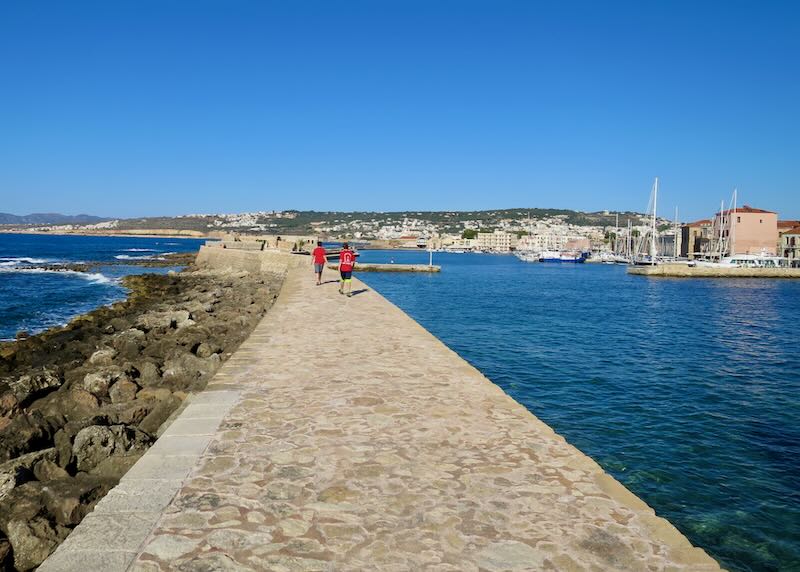
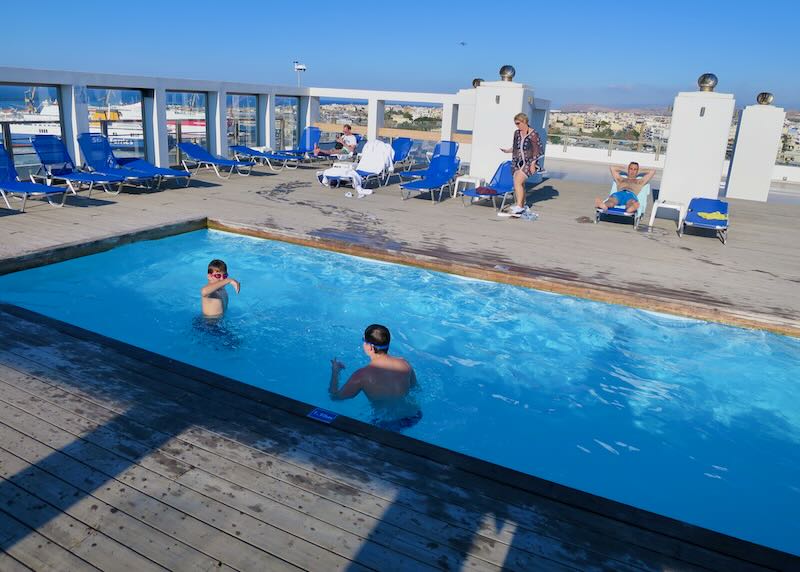
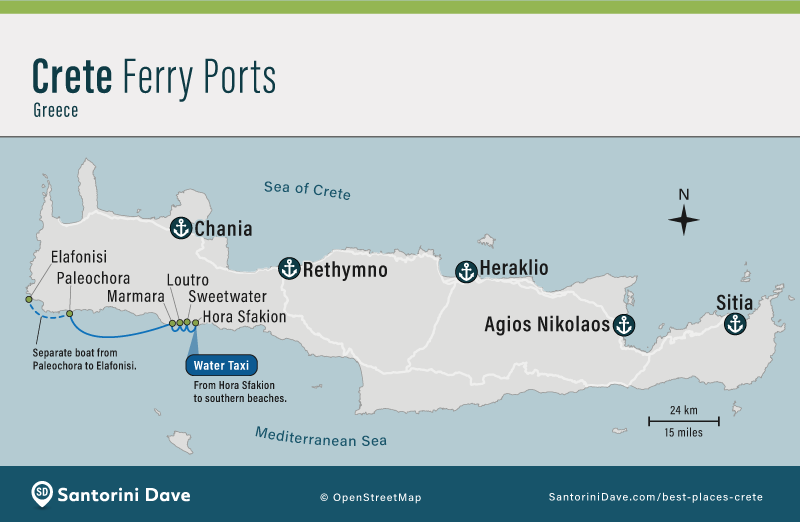
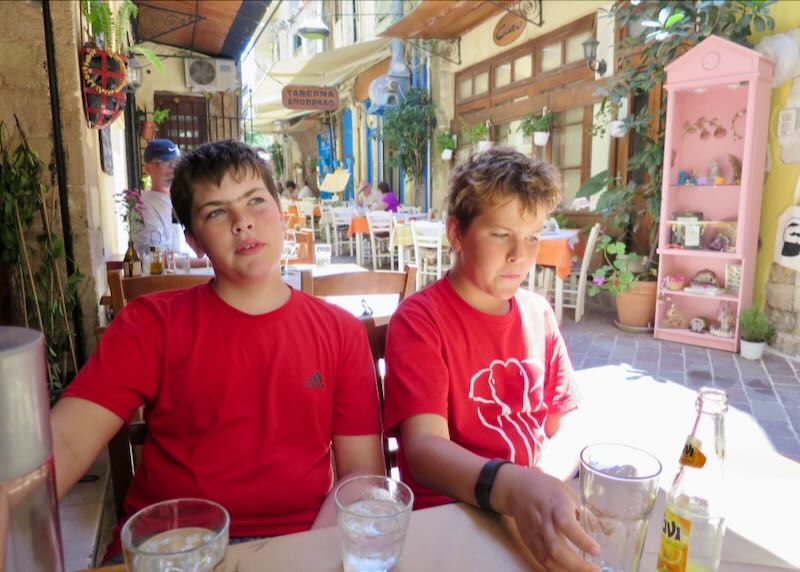
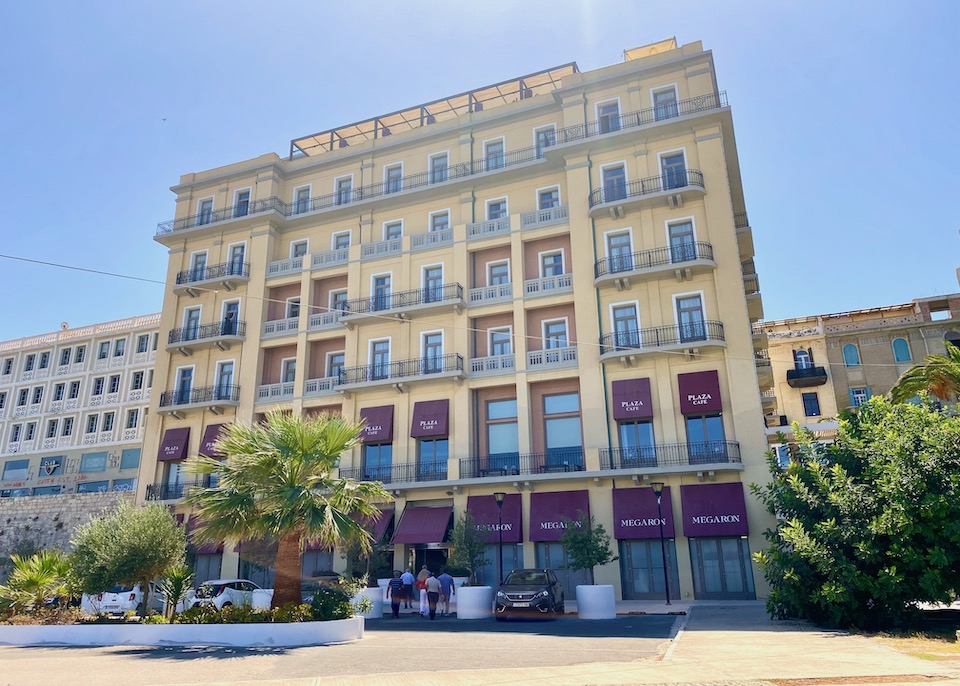
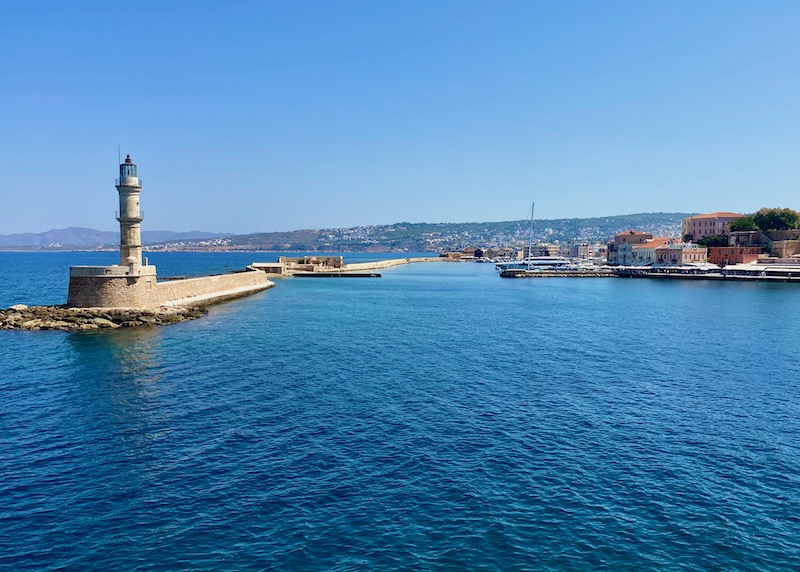

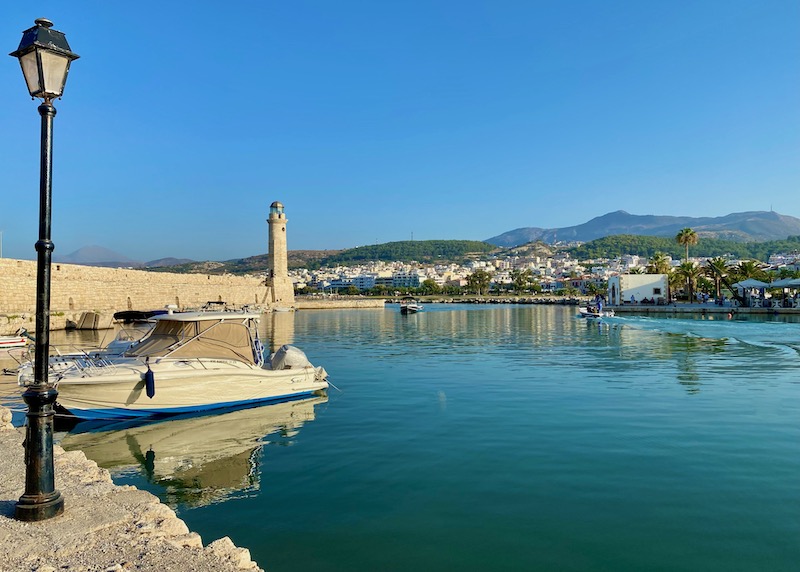

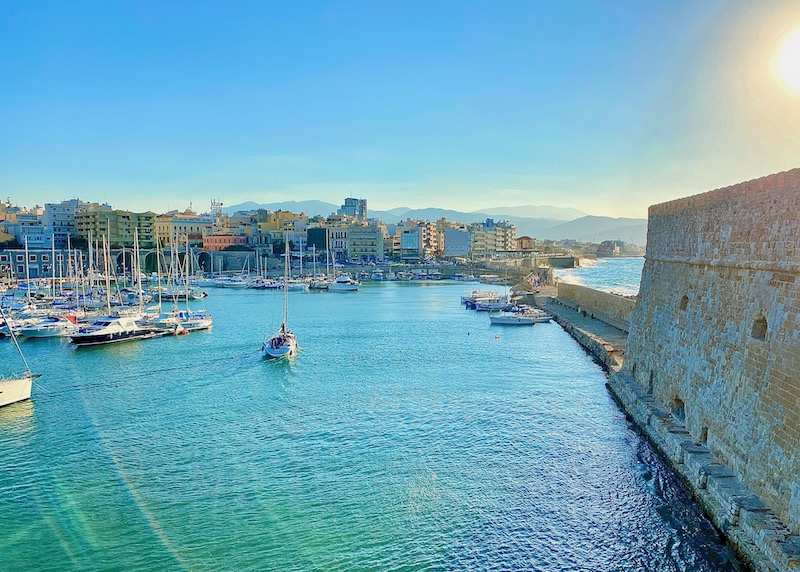

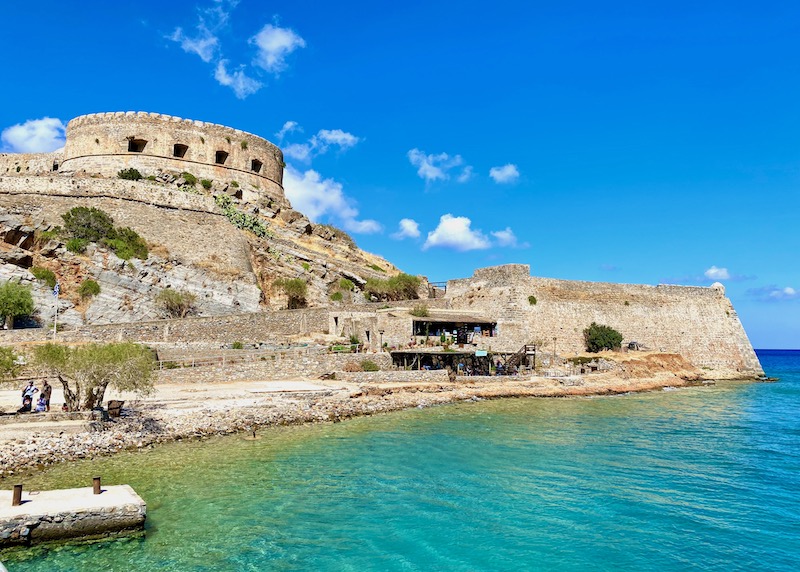

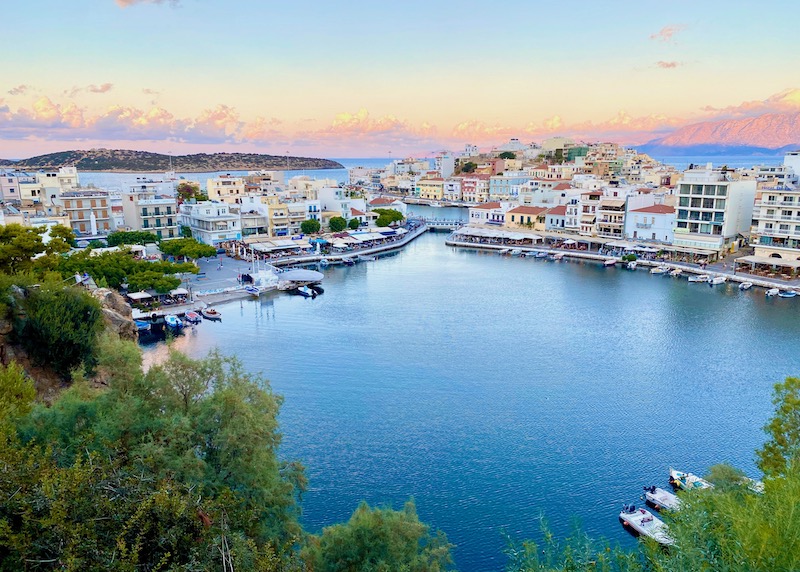

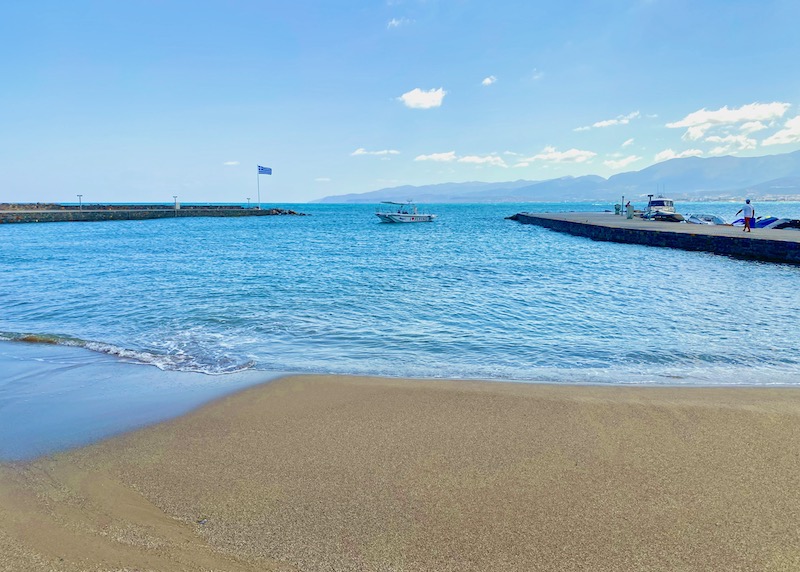

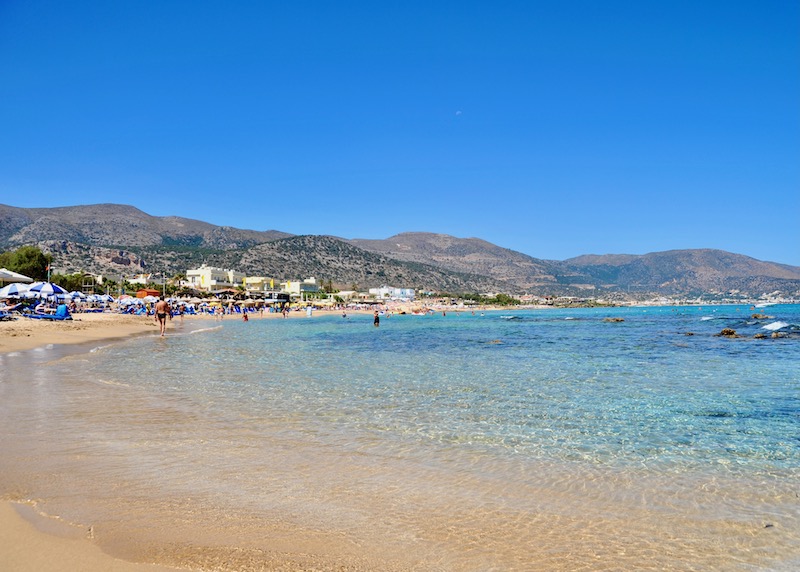

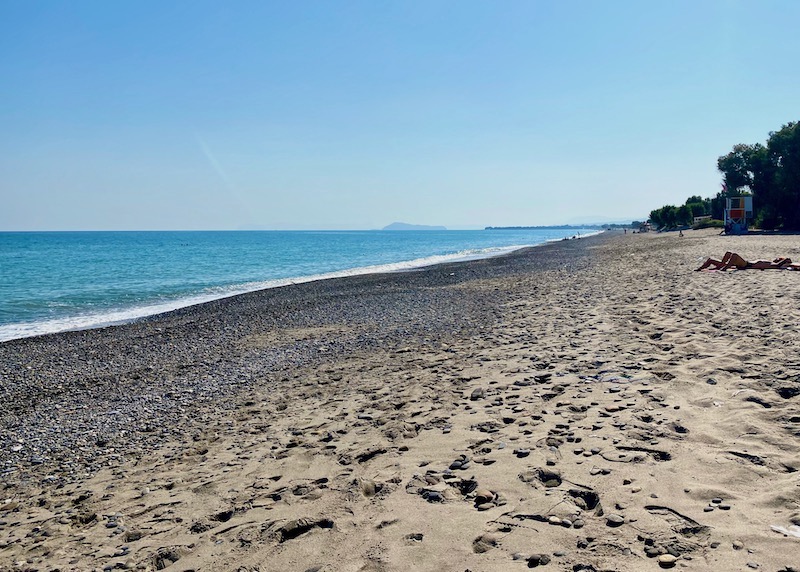

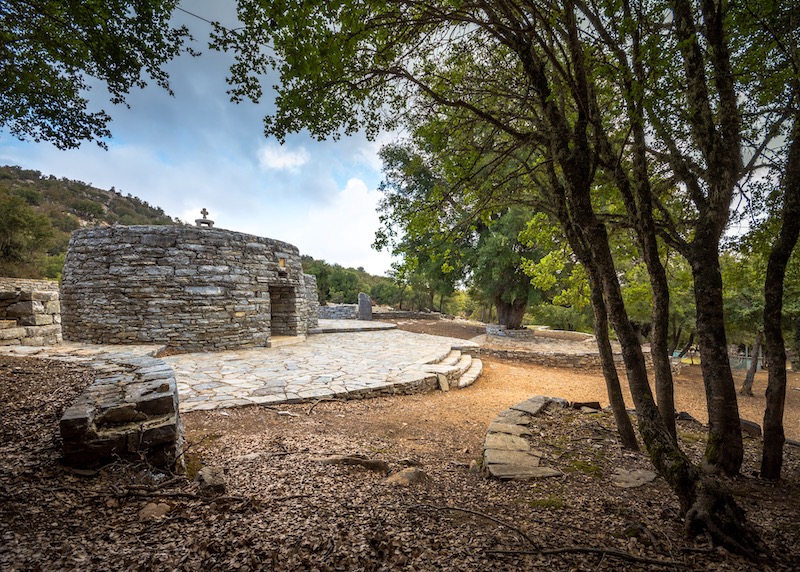

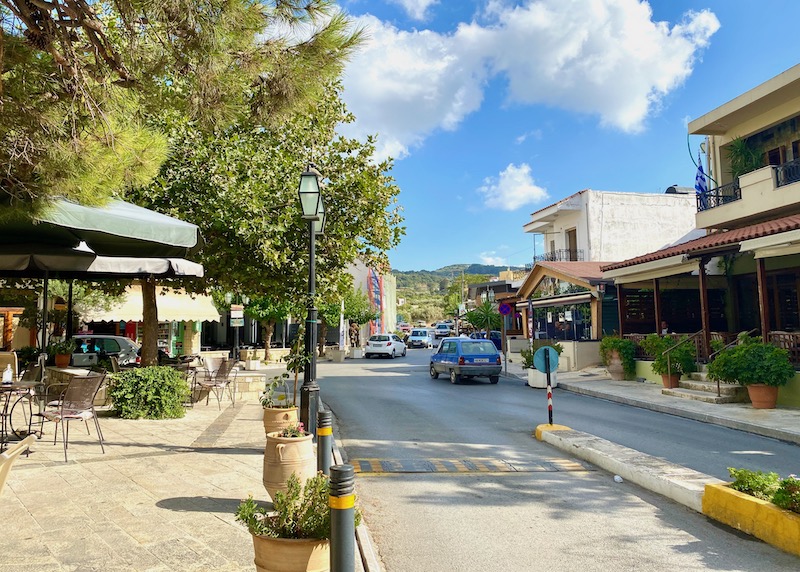

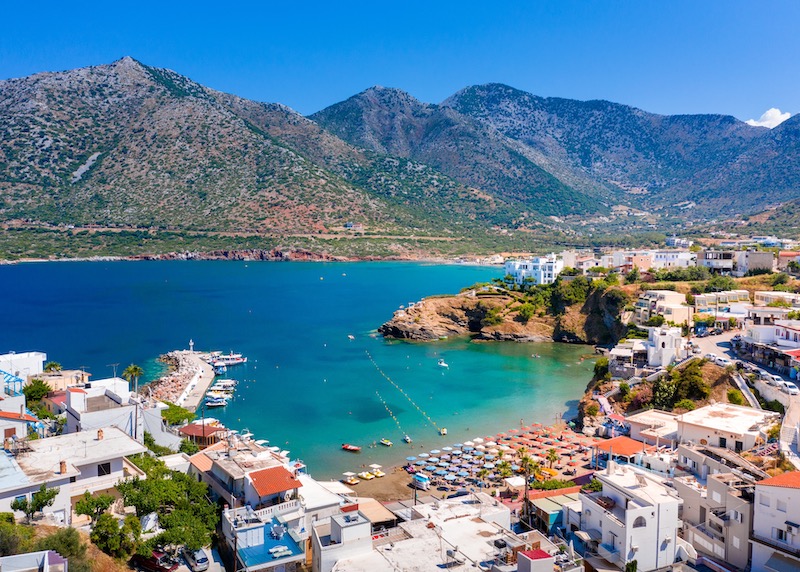

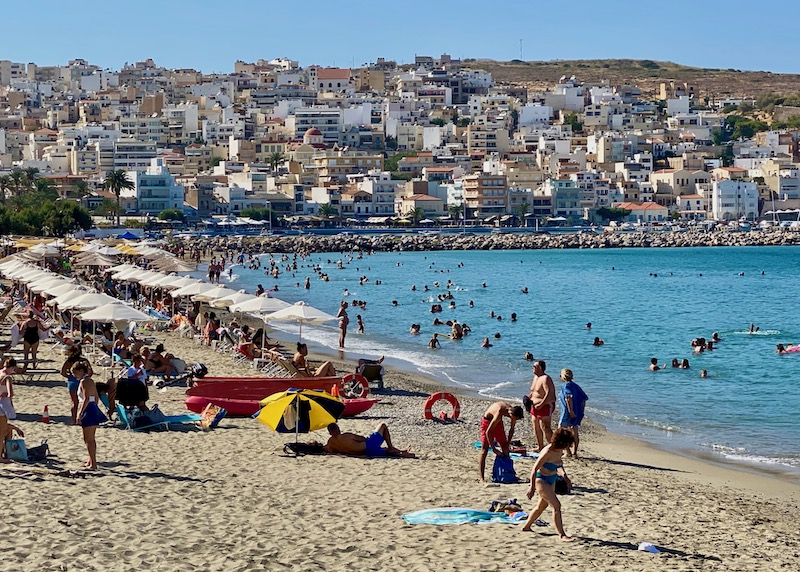

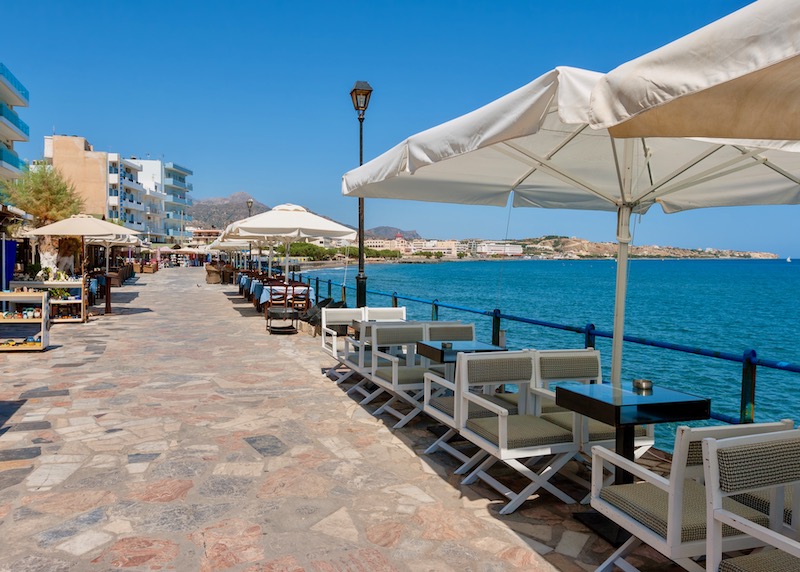

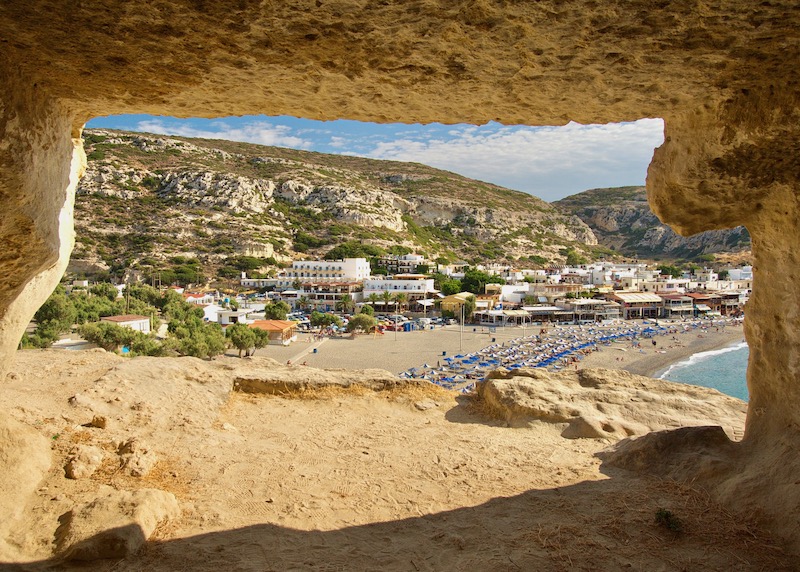

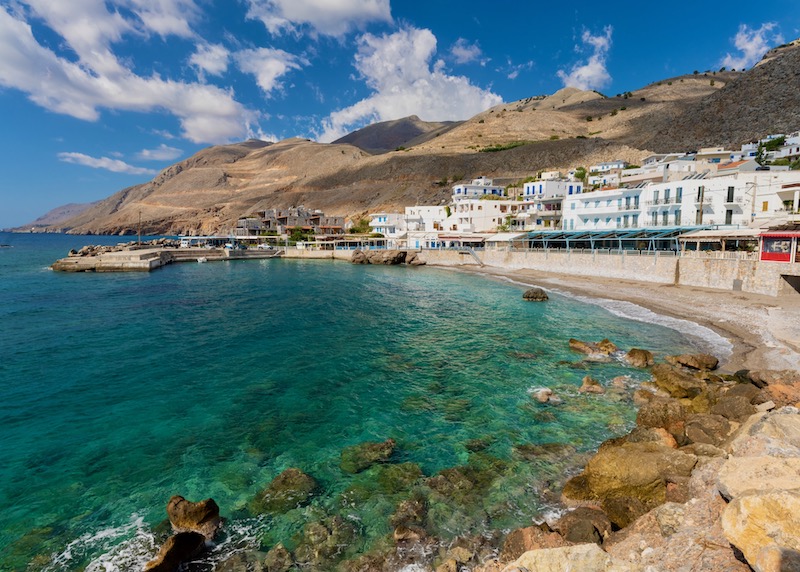

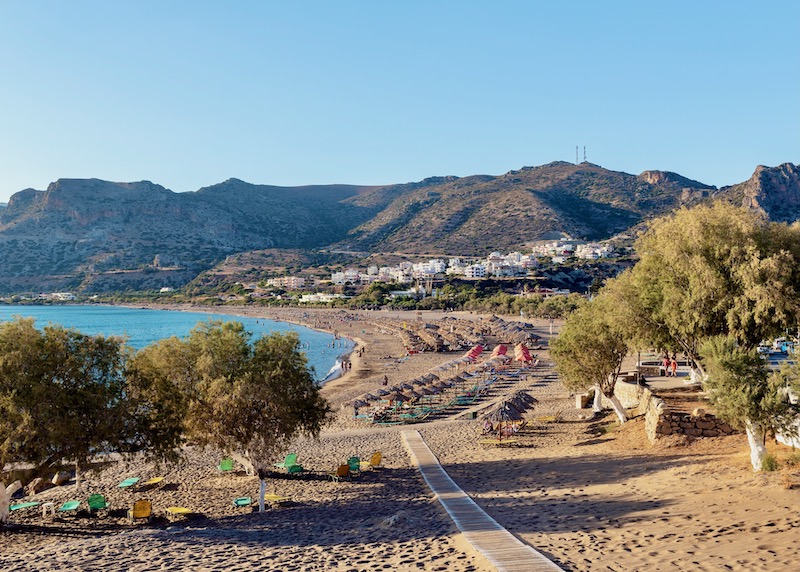

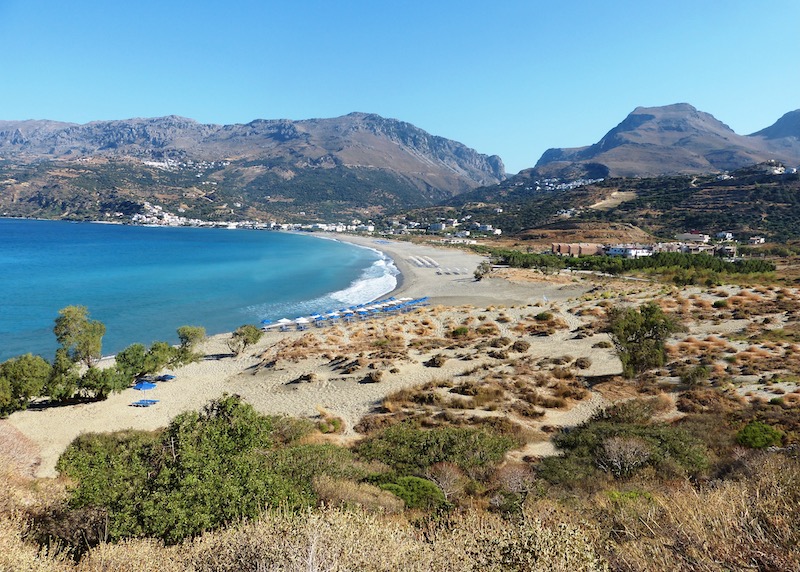

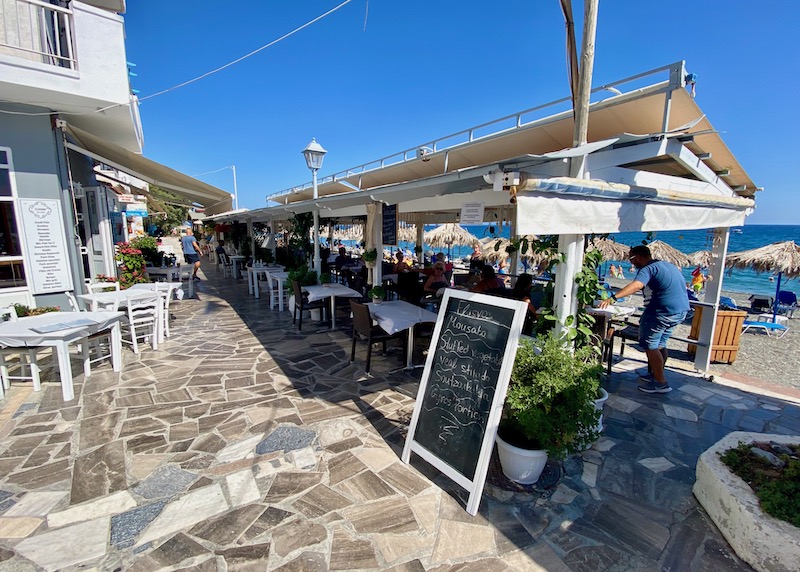

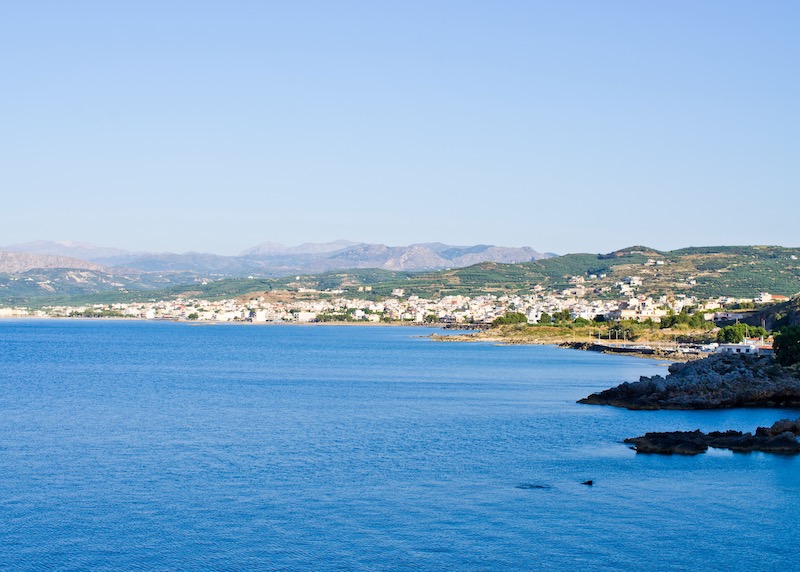

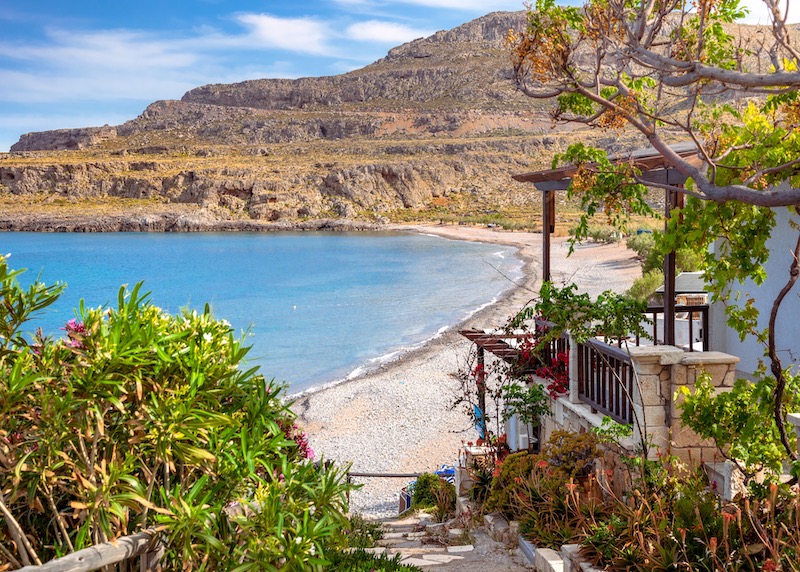

About Santorini Dave